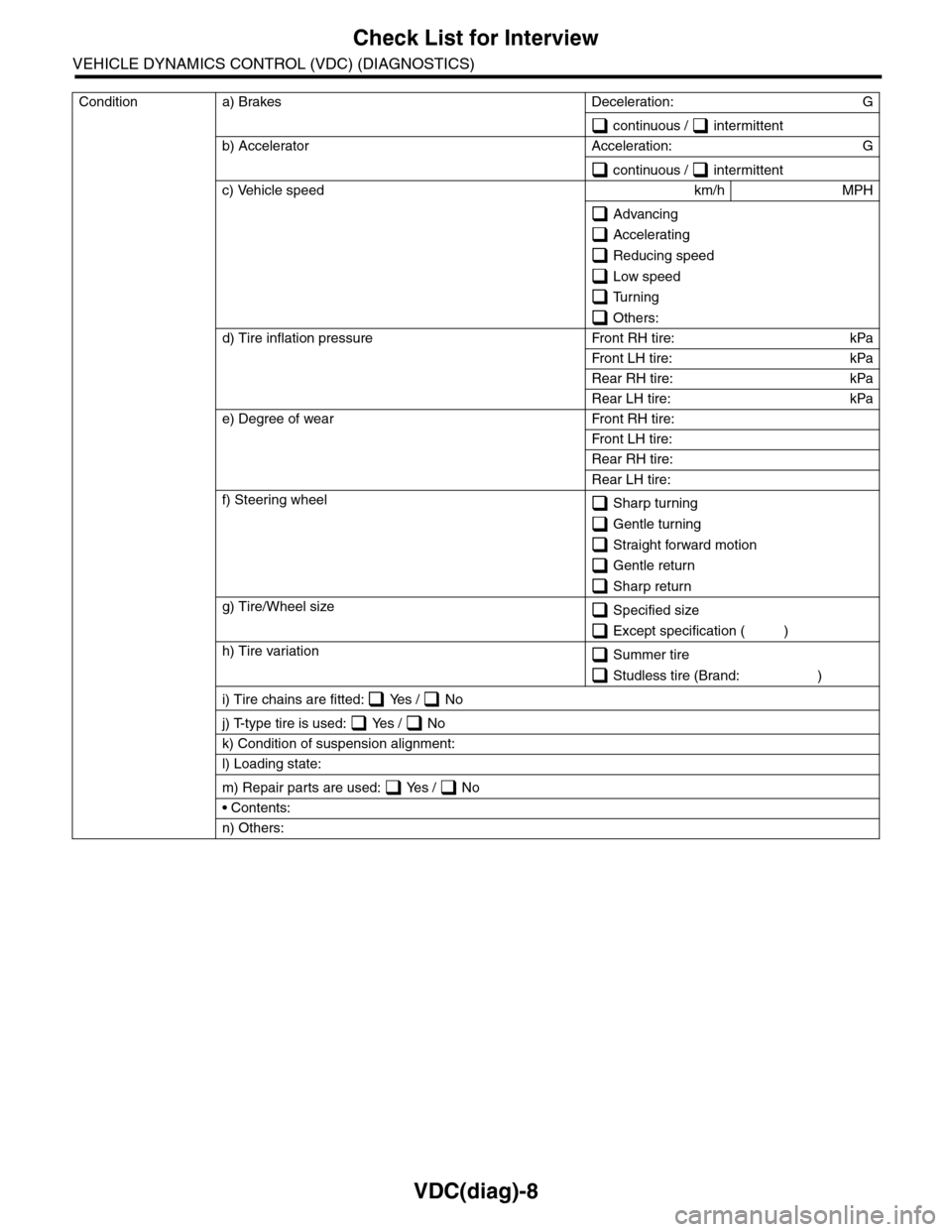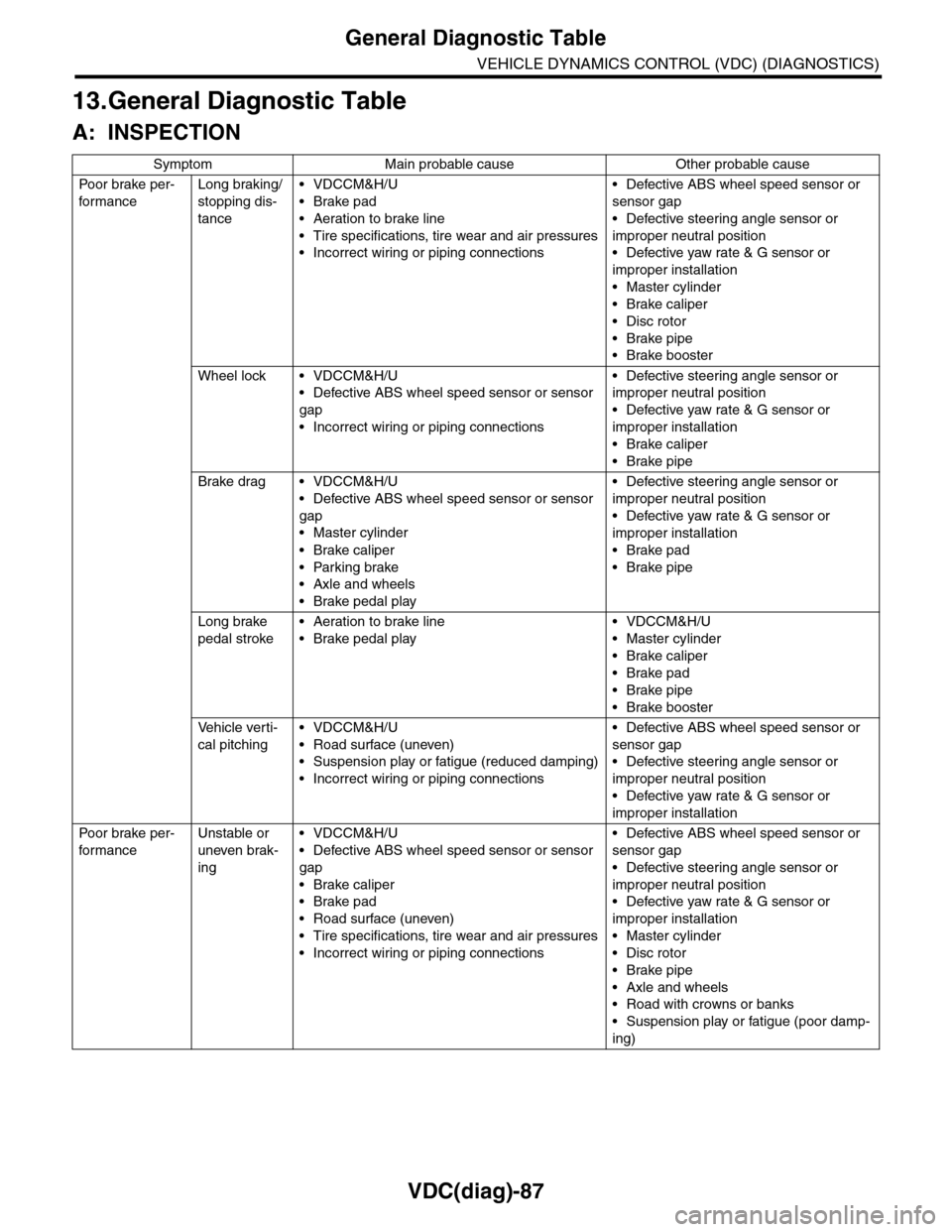2009 SUBARU TRIBECA tire pressure
[x] Cancel search: tire pressurePage 982 of 2453

TPM(diag)-32
Diagnostic Procedure with Diagnostic Trouble Code (DTC)
TIRE PRESSURE MONITORING SYSTEM (DIAGNOSTICS)
M: DTC 41 FL TRANS FUNCTION CODE ABNORMAL
NOTE:
Refer to DTC 44 for diagnostic procedure.
N: DTC 42 FR TRANS FUNCTION CODE ABNORMAL
NOTE:
Refer to DTC 44 for diagnostic procedure.
O: DTC 43 RR TRANS FUNCTION CODE ABNORMAL
NOTE:
Refer to DTC 44 for diagnostic procedure.
P: DTC 44 RL TRANS FUNCTION CODE ABNORMAL
DTC DETECTING CONDITION:
Unexpected function codes received from each transmitter.
TROUBLE SYMPTOM:
Tire pressure warning light blinks.
Step Check Yes No
1START FL TRANSMITTER.
1) Connect the Subaru Select Monitor and
then turn the ignition switch to ON.
2) Select “Transmitter ID”.
TION, Subaru Select Monitor.>
3) Use the transmitter registration tool and
transmit the ID from the FL transmitter to check
“Latest Received ID”.
Is “Latest Received ID”
updated?
Go to step 2.Replace the FL
transmitter.
REMOVAL, Tire
Pressure Monitor-
ing System.>
2CHECK FL TRANSMITTER ID.
Check the ID displayed in the updated ID dis-
play and the FL registered ID.
Are the two IDs same? Go to step 3.Record the
received ID update
as the FL transmit-
ter. Go to step 3.
3START FR TRANSMITTER.
Use the transmitter registration tool and trans-
mit the ID from the FR transmitter to check
“Latest Received ID”.
Is “Latest Received ID”
updated?
Go to step 4.Replace the FR
transmitter.
REMOVAL, Tire
Pressure Monitor-
ing System.>
4CHECK FR TRANSMITTER ID.
Check the ID displayed in the updated ID dis-
play and the FR registered ID.
Are the two IDs same? Go to step 5.Record the
received ID update
as the FR trans-
mitter. Go to step
5.
5START RR TRANSMITTER.
Use the transmitter registration tool and trans-
mit the ID from the RR transmitter to check
“Latest Received ID”.
Is “Latest Received ID”
updated?
Go to step 6.Replace the RR
transmitter.
REMOVAL, Tire
Pressure Monitor-
ing System.>
6CHECK RR TRANSMITTER ID.
Check the ID displayed in the updated ID dis-
play and the RR registered ID.
Are the two IDs same? Go to step 7.Record the
received ID update
as the RR trans-
mitter. Go to step
7.
Page 983 of 2453

TPM(diag)-33
Diagnostic Procedure with Diagnostic Trouble Code (DTC)
TIRE PRESSURE MONITORING SYSTEM (DIAGNOSTICS)
Q: DTC 51 FL TRANSMIT BATTERY LOW VOLTAGE
NOTE:
Refer to DTC 54 for diagnostic procedure.
R: DTC 52 FR TRANSMIT BATTERY LOW VOLTAGE
NOTE:
Refer to DTC 54 for diagnostic procedure.
S: DTC 53 RR TRANSMIT BATTERY LOW VOLTAGE
NOTE:
Refer to DTC 54 for diagnostic procedure.
T: DTC 54 RL TRANSMIT BATTERY LOW VOLTAGE
DTC DETECTING CONDITION:
Low battery signals received 20 times from each transmitter.
TROUBLE SYMPTOM:
Tire pressure warning light blinks.
7START RL TRANSMITTER.
Use the transmitter registration tool and trans-
mit the ID from the RL transmitter to check
“Latest Received ID”.
Is “Latest Received ID”
updated?
Go to step 8.Replace the RL
transmitter.
REMOVAL, Tire
Pressure Monitor-
ing System.>
8CHECK RL TRANSMITTER ID.
Check the ID displayed in the updated ID dis-
play and the RL registered ID.
Are the two IDs same? Go to step 9.Record the
received ID update
as the RL transmit-
ter. Go to step 9.
9CHECK MALFUNCTION TRANSMITTER.Is ID recorded by this proce-
dure?
Go to step 10.Replace the trans-
mitter indicated by
DTC.
Tire Pressure
Monitoring Sys-
tem.>
10 CHECK MALFUNCTION TRANSMITTER.
Check the registered ID of the transmitter indi-
cated by DTC.
Is there checked ID in the
record?
Replace the trans-
mitter of the
recorded position.
Pressure Monitor-
ing System.>
Replace the trans-
mitter indicated by
DTC.
Tire Pressure
Monitoring Sys-
tem.>
Step Check Yes No
Step Check Yes No
1CHECK TRANSMITTER.
1) Replace all transmitters with new ones and
register their IDs.
OPERATION, Subaru Select Monitor.>
2) Perform the clear memory mode, and per-
form driving test.
Is the fault eliminated? Transmitter
embedded battery
has worn out.
Pressure Monitor-
ing System.>
Replace the tire
pressure monitor-
ing control module.
Pressure Monitor-
ing System.>
Page 984 of 2453

TPM(diag)-34
Diagnostic Procedure with Diagnostic Trouble Code (DTC)
TIRE PRESSURE MONITORING SYSTEM (DIAGNOSTICS)
U: DTC 61 VEHICLE SPEED IS ABNORMAL
DTC DETECTING CONDITION:
Vehicle speed function codes were received from the transmitter, but the vehicle speed signal was not input
to the module.
TROUBLE SYMPTOM:
Tire pressure warning light blinks.
WIRING DIAGRAM:
TPM00020
4
COMBINATIONMETER
A:i10
A1
A27
R2
R7
R211
A2
I/F
8
9
TPM CONTROL MODULE
i102
1238910411 12 1314 15 16567
A:i10
12345 678910111219 20 2113 14 15 161718 22
R211
16
B310
MICROCOMPUTER
SPEEDOMETER
FB-17 F/B FUSE NO. 7(B)
TO POWER SUPPLYCIRCUIT
i3B38
B38
1234 5678910 11 12 13 14 15 16 17 18 19 20
36
VDC CONTROL MODULE
123456789101112
B310
12345678910 11 12 13 14
15 16 17 18 19 2021 22 23 24 25 26 27 2829 30 31 32 33 3435 36 37 38 39403940
27 283940
Page 985 of 2453

TPM(diag)-35
Diagnostic Procedure with Diagnostic Trouble Code (DTC)
TIRE PRESSURE MONITORING SYSTEM (DIAGNOSTICS)
Step Check Yes No
1CHECK TIRE PRESSURE MONITORING
CONTROL MODULE.
1) Connect an oscilloscope to the terminal No.
4 of the tire pressure monitoring control mod-
ule connector (R211)
2) Drive the vehicle at 40 km/h (25 MPH) for
20 seconds and check the vehicle speed signal
at that time.
Is the vehicle speed being
input?
Replace the tire
pressure monitor-
ing control module.
Pressure Monitor-
ing System.>
Go to step 2.
2CHECK HARNESS.
1) Disconnect the combination meter connec-
tor (i10).
2) Connect the tire pressure monitoring con-
trol module connector (R211) and combination
meter connector (i10) and measure the resis-
tance.
Is the resistance less than 0.5
Ω?
Check the combi-
nation meter.
bination Meter.>
Repair or replace
the open circuit of
the harness.
Page 986 of 2453

TPM(diag)-36
General Diagnostic Table
TIRE PRESSURE MONITORING SYSTEM (DIAGNOSTICS)
12.General Diagnostic Table
A: INSPECTION
Symptom Problem parts
Tire pressure warning light illumi-
nates.Tire pressure is reduced.•Improper tire pressure adjustment.
•Punctured tire
Tire pressure warning light blinks.
TIRE PRESSURE MONITOR-
ING SYSTEM HAS MALFUNC-
TION
•AIR PRESSURE SENSOR MALFUNCTION
•AIR PRESSURE SENSOR IS OUT OF BATTERY
•Tire pressure monitoring control module is faulty.
•Defective vehicle harness
Tire pressure is dropping but the
warning light does not illuminate.
TIRE PRESSURE WARNING
LIGHT DOES NOT ILLUMINATE
•AIR PRESSURE SENSOR IS FAULTY.
•Tire pressure monitoring control module is faulty.
•Defective vehicle harness
Page 1000 of 2453

VDC(diag)-8
Check List for Interview
VEHICLE DYNAMICS CONTROL (VDC) (DIAGNOSTICS)
Condition a) Brakes Deceleration: G
continuous / intermittent
b) Accelerator Acceleration: G
continuous / intermittent
c) Vehicle speed km/h MPH
Advancing
Accelerating
Reducing speed
Low speed
Turning
Others:
d) Tire inflation pressure Front RH tire: kPa
Fr o n t L H t ir e : kPa
Rear RH tire: kPa
Rear LH tire: kPa
e) Degree of wear Front RH tire:
Fr o n t L H t ir e :
Rear RH tire:
Rear LH tire:
f) Steering wheel Sharp turning
Gentle turning
Straight forward motion
Gentle return
Sharp return
g) Tire/Wheel size Specified size
Except specification ( )
h) Tire variation Summer tire
Studless tire (Brand: )
i) Tire chains are fitted: Yes / No
j) T-type tire is used: Yes / No
k) Condition of suspension alignment:
l) Loading state:
m) Repair parts are used: Yes / No
• Contents:
n) Others:
Page 1001 of 2453

VDC(diag)-9
General Description
VEHICLE DYNAMICS CONTROL (VDC) (DIAGNOSTICS)
3. General Description
A: CAUTION
1. SRS AIRBAG SYSTEM
Airbag system wiring harness is routed near the
ABS wheel speed sensor and VDCCM&H/U.
CAUTION:
•All airbag system wiring harness and con-
nectors are colored yellow. Do not use the elec-
trical test equipment on these circuits.
•Be careful not to damage the airbag system
wiring harness when servicing the ABS wheel
speed sensor and VDCCM&H/U.
B: INSPECTION
Before performing diagnosis, check the following
items which might affect VDC problems.
1. BATTERY
Measure the battery voltage and check electrolyte.
Standard voltage: 12 V or more
Specific gravity: 1.260 or more
2. GROUND
Check the tightening torque of ground (GB-7) bolt
of VDC.
Tightening torque:
13 N·m (1.3 kgf-m, 9.6 ft-lb)
3. BRAKE FLUID
1) Check the brake fluid level.
2) Check the brake fluid for leaks.
4. HYDRAULIC UNIT
Check the hydraulic unit.
•With brake tester
TESTER, INSPECTION, VDC Control Module &
Hydraulic Control Unit (VDCCM&H/U).>
•Without brake tester
USING A PRESSURE GAUGE, INSPECTION,
VDC Control Module & Hydraulic Control Unit (VD-
CCM&H/U).>
5. BRAKE DRAG
Check for brake drag.
6. BRAKE PAD AND ROTOR
Check the brake pad and rotor.
•Front
•Rear
7. TIRE
Check the tire specifications, tire wear and air pres-
sure.
Page 1079 of 2453

VDC(diag)-87
General Diagnostic Table
VEHICLE DYNAMICS CONTROL (VDC) (DIAGNOSTICS)
13.General Diagnostic Table
A: INSPECTION
Symptom Main probable cause Other probable cause
Po or b rake pe r -
for mance
Long braking/
stopping dis-
tance
•VDCCM&H/U
•Brake pad
•Aeration to brake line
•Tire specifications, tire wear and air pressures
•Incorrect wiring or piping connections
•Defective ABS wheel speed sensor or
sensor gap
•Defective steering angle sensor or
improper neutral position
•Defective yaw rate & G sensor or
improper installation
•Master cylinder
•Brake caliper
•Disc rotor
•Brake pipe
•Brake booster
Wheel lock • VDCCM&H/U
•Defective ABS wheel speed sensor or sensor
gap
•Incorrect wiring or piping connections
•Defective steering angle sensor or
improper neutral position
•Defective yaw rate & G sensor or
improper installation
•Brake caliper
•Brake pipe
Brake drag • VDCCM&H/U
•Defective ABS wheel speed sensor or sensor
gap
•Master cylinder
•Brake caliper
•Parking brake
•Axle and wheels
•Brake pedal play
•Defective steering angle sensor or
improper neutral position
•Defective yaw rate & G sensor or
improper installation
•Brake pad
•Brake pipe
Long brake
pedal stroke
•Aeration to brake line
•Brake pedal play
•VDCCM&H/U
•Master cylinder
•Brake caliper
•Brake pad
•Brake pipe
•Brake booster
Ve h i c l e v e r t i -
cal pitching
•VDCCM&H/U
•Road surface (uneven)
•Suspension play or fatigue (reduced damping)
•Incorrect wiring or piping connections
•Defective ABS wheel speed sensor or
sensor gap
•Defective steering angle sensor or
improper neutral position
•Defective yaw rate & G sensor or
improper installation
Po or b rake pe r -
for mance
Unstable or
uneven brak-
ing
•VDCCM&H/U
•Defective ABS wheel speed sensor or sensor
gap
•Brake caliper
•Brake pad
•Road surface (uneven)
•Tire specifications, tire wear and air pressures
•Incorrect wiring or piping connections
•Defective ABS wheel speed sensor or
sensor gap
•Defective steering angle sensor or
improper neutral position
•Defective yaw rate & G sensor or
improper installation
•Master cylinder
•Disc rotor
•Brake pipe
•Axle and wheels
•Road with crowns or banks
•Suspension play or fatigue (poor damp-
ing)